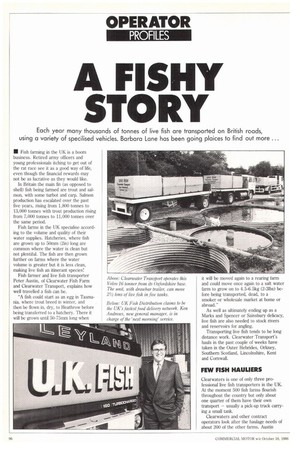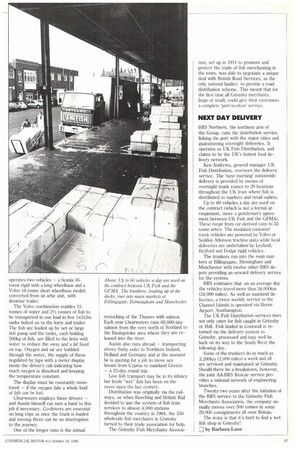A FISHY STORY
Page 98

Page 99

If you've noticed an error in this article please click here to report it so we can fix it.
Each year many thousands of tonnes of live fish are transported on British roads, using a variety of specilised vehicles. Barbara Lane has been going plaices to find out more
• Fish farming in the UK is a boom business. Retired army officers and young professionals itching to get out of the rat race see it as a good way of life, even though the financial rewards may not be as lucrative as they would like.
In Britain the main fin (as opposed to shell) fish being farmed are trout and salmon, with some turbot and carp. Salmon production has escalated over the past five years, rising from 1,800 tonnes to 13,000 tonnes with trout production rising from 7,000 tonnes to 11,000 tonnes over the same period.
Fish farms in the UK specialise according to the volume and quality of their water supplies. Hatcheries, where fish are grown up to 50nrun (2in) long are common where the water is clean but not plentiful. The fish are then grown further on farms where the water volume is greater but it is less clean, making live fish an itinerant species?
Fish farmer and live fish transporter Peter Austin, of Clearwater Fish Farm and Clearwater Transport, explains how well travelled a fish can be.
"A fish could start as an egg in Tasmania, where trout breed in winter, and then be flown in, dry, to Heathrow before being transferred to a hatchery. There it will be grown until 50-75mm long when it will be moved again to a rearing farm and could move once again to a salt water farm to grow on to 4.5-6.5kg (2-31bs) before being transported, dead, to a smoker or wholesale market at home or abroad."
As well as ultimately ending up as a Marks and Spencer or Sainsbury delicacy, live fish are also needed to stock rivers and reservoirs for angling.
Transporting live fish tends to be long distance work. Clearwater Transport's hauls in the past couple of weeks have taken in the Outer Hebrides, Orkney, Southern Scotland, Lincolnshire, Kent and Cornwall.
FEW FISH HAULIERS
Clearwaters is one of only three professional live fish transporters in the UK. At the moment 500 fish farms flourish throughout the country but only about one quarter of them have their own transport — usually a pick-up truck carrying a small tank.
Clearwaters and other contract operators look after the haulage needs of about 200 of the other farms. Austin operates two vehicles — a Scania 16tonne rigid with a long wheelbase and a Volvo 16-tonne short wheelbase model, converted from an artic unit, with drawbar trailer.
The Volvo combination enables 15 tonnes of water and 21/2 tonnes of fish to be transported in one load in five 1x2x2m tanks bolted on to the lorry and trailer. The fish are loaded up by net or large fish pump and the tanks, each holding 500kg of fish, are filled to the brim with water to reduce the sway and a lid fixed on top. Oxygen and air are bubbled through the water, the supply of these regulated by taps with a meter display inside the driver's cab indicating how much oxygen is dissolved and keeping the temperature constant.
The display must be constantly monitored — if the oxygen fails a whole load of fish can he lost.
Clearwaters employs three drivers — and Austin himself can turn a hand to this job if necessary. Co-drivers are essential on long trips as once the truck is loaded and moving there can be no interruption to the journey.
One of the longer runs is the annual
restocking of the Thames with salmon. Each year Clearwaters runs 60,000 tiny salmon from the very north of Scotland to the Basingstoke area where they are released into the river.
Austin also runs abroad — transporting elvers (baby eels) to Northern Ireland, Holland and Germany and at the moment he is quoting for a job to move sea bream from Cyprus to mainland Greece — a 22-day round trip.
Live fish transport may be in its infancy but fresh "wet" fish has been on the move since the last century.
Distribution was originally via the railways, so when Beeching and British Rail decided to axe the system of fish train services to almost 4,000 stations throughout the country in 1964, the 350 wholesale fish merchants in Grimsby turned to their trade association for help.
The Grimsby Fish Merchants Associa tion, set up in 1911 to promote and protect the trade of fish merchanting in the town, was able to negotiate a unique deal with British Road Services, as the only national haulier, to provide a road distribution scheme. This meant that for the first time all Grimsby merchants, large or small, could give their customers a complete 'port-to-door' service.
NEXT DAY DELIVERY
BRS Northern, the northern arm of the Group, runs the distribution service, linking the port with the major cities and guaranteeing overnight deliveries. It operates as UK Fish Distribution, and claims to be the UK's fastest food delivery network.
Ken Andrews, general manager UK Fish Distribution, oversees the delivery service. The 'next morning' nationwide delivery is provided by means of overnight trunk routes to 20 locations throughout the UK from where fish is distributed to markets and retail outlets.
Up to 60 vehicles a day are used on the contract (which is not a formal arrangement, more a gentleman's agreement between UK Fish and the GINA). These range from car-derived vans to 32tonne artics. The insulated container trunk vehicles are powered by Volvo or Seddon Atkinson tractive units while local deliveries are undertaken by Leyland, Bedford and Dodge rigid vehicles.
The trunkers run into the main markets at Billingsgate, Birmingham and Manchester with twelve other BRS depots providing an onward delivery service for the system.
BRS estimates that on an average day the vehicles travel more than 38,000km (24,000 miles). As well as mainland deliveries, a twice-weekly service to the Channel Islands is operated via Herne Airport, Southampton.
The UK Fish Distribution services does not only cater for fish caught in Grimsby or Hull. Fish landed in Cornwall is returned via the delivery system to Grimsby, processed and may well be back on its way to the South West the following day.
Some of the trunkers do as much as 3,200km (2,000 miles) a week and all are serviced and maintained at Grimsby. Should there be a breakdown, however, the joint AA/BRS Rescue service provides a national network of engineering branches.
Twenty-two years after the initiation of the BRS service to the Grimsby Fish Merchants Association, the company annually moves over 500 tonnes in some 20,000 consignments all over Britain.
The irony is that it's hard to find a wet fish shop in Grimsby!
El by Barbara Lane
































































































































































































